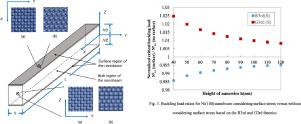当前位置:
X-MOL 学术
›
Int. J. Mech. Sci.
›
论文详情
Our official English website, www.x-mol.net, welcomes your
feedback! (Note: you will need to create a separate account there.)
Assessment of first and third order shear deformation beam theories for the buckling and vibration analysis of nanobeams incorporating surface stress effects
International Journal of Mechanical Sciences ( IF 7.1 ) Pub Date : 2020-11-01 , DOI: 10.1016/j.ijmecsci.2020.105873 F. Lin , L.H. Tong , H.-S. Shen , C.W. Lim , Y. Xiang
International Journal of Mechanical Sciences ( IF 7.1 ) Pub Date : 2020-11-01 , DOI: 10.1016/j.ijmecsci.2020.105873 F. Lin , L.H. Tong , H.-S. Shen , C.W. Lim , Y. Xiang

|
Abstract A novel approach for the vibration and buckling analysis of nanobeams with surface stress effects is presented in this paper. The material model is derived in which the bulk core of a beam is assumed to be a single crystalline material and have certain crystallographic directions. The beams are assumed to be covered by atomic layers with the same crystallographic directions on the top and bottom surfaces. A generic third order shear deformable beam theory is employed to derive the total energy functional of the beams. Minimizing the total potential energy functional by applying the p-Ritz method, the eigenvalue equations for the buckling and vibration of nanobeams with surface stress effects are obtained. The buckling and vibration behaviours of the beams considering the surface stress effects are discussed in detail and are compared with the results obtained from the first order beam theory and the Reddy's third order beam theory. It is found that in certain cases, both the first order and the Reddy's third order beam theories may not be able to capture the surface effect accurately on the vibration and buckling behaviours of the nanobeams. The effects of surface stresses on the buckling and vibration behaviours for nanobeams made of Ni single crystals obtained by the generic third order beam theory showed opposite trends to the ones obtained by the first order or the Reddy's third beam theory.
中文翻译:

评估一阶和三阶剪切变形梁理论,用于结合表面应力效应的纳米梁屈曲和振动分析
摘要 本文提出了一种具有表面应力效应的纳米梁振动和屈曲分析的新方法。推导出材料模型,其中梁的体核被假定为单晶材料并具有特定的结晶方向。假定光束被顶面和底面具有相同结晶方向的原子层覆盖。采用通用的三阶剪切变形梁理论来推导梁的总能量函数。应用p-Ritz法最小化总势能函数,得到了具有表面应力效应的纳米梁屈曲和振动的特征值方程。详细讨论了考虑表面应力效应的梁的屈曲和振动行为,并与从一阶梁理论和雷迪三阶梁理论获得的结果进行了比较。研究发现,在某些情况下,一阶和雷迪三阶梁理论可能无法准确捕捉纳米梁振动和屈曲行为的表面效应。通过通用三阶梁理论获得的由 Ni 单晶制成的纳米梁的表面应力对屈曲和振动行为的影响与通过一阶或雷迪三梁理论获得的趋势相反。一阶和雷迪三阶梁理论可能无法准确地捕捉纳米梁振动和屈曲行为的表面效应。通过通用三阶梁理论获得的由 Ni 单晶制成的纳米梁的表面应力对屈曲和振动行为的影响与通过一阶或雷迪三梁理论获得的趋势相反。一阶和雷迪三阶梁理论可能无法准确地捕捉纳米梁振动和屈曲行为的表面效应。通过通用三阶梁理论获得的由 Ni 单晶制成的纳米梁的表面应力对屈曲和振动行为的影响与通过一阶或雷迪三梁理论获得的趋势相反。
更新日期:2020-11-01
中文翻译:

评估一阶和三阶剪切变形梁理论,用于结合表面应力效应的纳米梁屈曲和振动分析
摘要 本文提出了一种具有表面应力效应的纳米梁振动和屈曲分析的新方法。推导出材料模型,其中梁的体核被假定为单晶材料并具有特定的结晶方向。假定光束被顶面和底面具有相同结晶方向的原子层覆盖。采用通用的三阶剪切变形梁理论来推导梁的总能量函数。应用p-Ritz法最小化总势能函数,得到了具有表面应力效应的纳米梁屈曲和振动的特征值方程。详细讨论了考虑表面应力效应的梁的屈曲和振动行为,并与从一阶梁理论和雷迪三阶梁理论获得的结果进行了比较。研究发现,在某些情况下,一阶和雷迪三阶梁理论可能无法准确捕捉纳米梁振动和屈曲行为的表面效应。通过通用三阶梁理论获得的由 Ni 单晶制成的纳米梁的表面应力对屈曲和振动行为的影响与通过一阶或雷迪三梁理论获得的趋势相反。一阶和雷迪三阶梁理论可能无法准确地捕捉纳米梁振动和屈曲行为的表面效应。通过通用三阶梁理论获得的由 Ni 单晶制成的纳米梁的表面应力对屈曲和振动行为的影响与通过一阶或雷迪三梁理论获得的趋势相反。一阶和雷迪三阶梁理论可能无法准确地捕捉纳米梁振动和屈曲行为的表面效应。通过通用三阶梁理论获得的由 Ni 单晶制成的纳米梁的表面应力对屈曲和振动行为的影响与通过一阶或雷迪三梁理论获得的趋势相反。











































 京公网安备 11010802027423号
京公网安备 11010802027423号